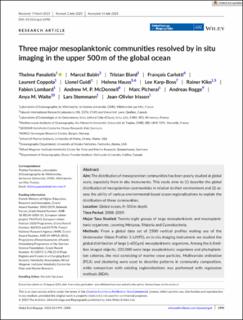| dc.contributor.author | Panaïotis, Thelma | |
| dc.contributor.author | Babin, Marcel | |
| dc.contributor.author | Biard, Tristan | |
| dc.contributor.author | Carlotti, François | |
| dc.contributor.author | Coppola, Laurent | |
| dc.contributor.author | Guidi, Lionel | |
| dc.contributor.author | Hauss, Helena | |
| dc.contributor.author | Karp‐Boss, Lee | |
| dc.contributor.author | Kiko, Rainer | |
| dc.contributor.author | Lombard, Fabien | |
| dc.contributor.author | McDonnell, Andrew M.P. | |
| dc.contributor.author | Picheral, Marc | |
| dc.contributor.author | Rogge, Andreas | |
| dc.contributor.author | Waite, Anya M. | |
| dc.contributor.author | Stemmann, Lars | |
| dc.contributor.author | Irisson, Jean-Olivier | |
| dc.date.accessioned | 2024-02-21T13:38:31Z | |
| dc.date.available | 2024-02-21T13:38:31Z | |
| dc.date.created | 2023-08-07T14:15:12Z | |
| dc.date.issued | 2023 | |
| dc.identifier.citation | Global Ecology and Biogeography. 2023, 32 (11), 1991-2005. | en_US |
| dc.identifier.issn | 1466-822X | |
| dc.identifier.uri | https://hdl.handle.net/11250/3119075 | |
| dc.description.abstract | Aim The distribution of mesoplankton communities has been poorly studied at global scale, especially from in situ instruments. This study aims to (1) describe the global distribution of mesoplankton communities in relation to their environment and (2) assess the ability of various environmental-based ocean regionalizations to explain the distribution of these communities. Location Global ocean, 0–500 m depth. Time Period 2008–2019. Major Taxa Studied Twenty-eight groups of large mesoplanktonic and macroplanktonic organisms, covering Metazoa, Rhizaria and Cyanobacteria. Methods From a global data set of 2500 vertical profiles making use of the Underwater Vision Profiler 5 (UVP5), an in situ imaging instrument, we studied the global distribution of large (>600 μm) mesoplanktonic organisms. Among the 6.8 million imaged objects, 330,000 were large zooplanktonic organisms and phytoplankton colonies, the rest consisting of marine snow particles. Multivariate ordination (PCA) and clustering were used to describe patterns in community composition, while comparison with existing regionalizations was performed with regression methods (RDA). Results Within the observed size range, epipelagic plankton communities were Trichodesmium-enriched in the intertropical Atlantic, Copepoda-enriched at high latitudes and in upwelling areas, and Rhizaria-enriched in oligotrophic areas. In the mesopelagic layer, Copepoda-enriched communities were also found at high latitudes and in the Atlantic Ocean, while Rhizaria-enriched communities prevailed in the Peruvian upwelling system and a few mixed communities were found elsewhere. The comparison between the distribution of these communities and a set of existing regionalizations of the ocean suggested that the structure of plankton communities described above is mostly driven by basin-level environmental conditions. Main Conclusions In both layers, three types of plankton communities emerged and seemed to be mostly driven by regional environmental conditions. This work sheds light on the role not only of metazoans, but also of unexpected large protists and cyanobacteria in structuring large mesoplankton communities. | en_US |
| dc.description.abstract | Three major mesoplanktonic communities resolved by in situ imaging in the upper 500 m of the global ocean | en_US |
| dc.language.iso | eng | en_US |
| dc.rights | Navngivelse-Ikkekommersiell 4.0 Internasjonal | * |
| dc.rights.uri | http://creativecommons.org/licenses/by-nc/4.0/deed.no | * |
| dc.subject | Plankton | en_US |
| dc.subject | Plankton | en_US |
| dc.title | Three major mesoplanktonic communities resolved by in situ imaging in the upper 500 m of the global ocean | en_US |
| dc.title.alternative | Three major mesoplanktonic communities resolved by in situ imaging in the upper 500 m of the global ocean | en_US |
| dc.type | Peer reviewed | en_US |
| dc.type | Journal article | en_US |
| dc.rights.holder | © 2023 The Authors | en_US |
| dc.description.version | publishedVersion | en_US |
| cristin.ispublished | true | |
| cristin.fulltext | original | |
| cristin.qualitycode | 2 | |
| dc.identifier.doi | 10.1111/geb.13741 | |
| dc.identifier.cristin | 2165361 | |
| dc.source.journal | Global Ecology and Biogeography | en_US |
| dc.source.volume | 32 | en_US |
| dc.source.issue | 11 | en_US |
| dc.source.pagenumber | 1991-2005 | en_US |
| dc.relation.project | Andre: French Ministry of Higher ERI grant #3500/2019 | en_US |
| dc.relation.project | Deutsche Forschungsgemeinschaft: KI 1387/5-1 | en_US |
| dc.relation.project | EC/H2020/817578 | en_US |
| dc.relation.project | Andre: Programme d'Investissements d'Avenir #ANR-19-MPGA-0012 | en_US |
| dc.relation.project | EC/H2020/862923 | en_US |
| dc.relation.project | Andre: Belmont Forum grant #ANR-18-BELM-0003-01 | en_US |
| dc.subject.nsi | VDP::Marinbiologi: 497 | en_US |
| dc.subject.nsi | VDP::Marine biology: 497 | en_US |

